I wander why that happened. smallPreceding unsigned comment was added by Sillybellsup(Talk;Contribs)sup24 November Please sign your posts with ~~~~smalldddldlddthis happened to me too I was playing one of the seeds I found that where made to be hard and when I died I made a new one because it was on hardcore mode and when I loaded it all the trees I cut down where gone and the house I built was there smallPreceding unsigned comment was added by sup(Talk)sup30 January Please sign your posts with ~~~~smalldddlh3Why was this moved to "Seed (Single player)"?[edit]h3pAll of the info here also applies to SMP.
SMP servers can set a seed in the [HOST]ties file, and it behaves the same way single-player seeds do.
Vav diffuser with thermostat/
Compared with Constant Air Volume (CAV) system or fan coil unit plus fresh air system, VAV diffuser system can reduce the common problems vav diffuser with thermostat over cold or over heat. Less pressure is required for air handling unit, therefore to save 15~48% energy. Initial cost of VAV diffuser system is about 15% lower than the traditional VAV system (VAV boxes + air diffusers). Operation and maintenance is easier for VAV diffuser system.

Ducting design shall ensure static pressure at VAV diffuser inlet not more than 62Pa, and not less than 12Pa at the worst point of ducting, for sake of keeping the regulating performance of VAV diffuser. The best method to realize the design target is to calculate proper length and size of duct base on the maximum allowed pressure drop between the first and the last VAV diffuser.
The air flow balance among duct branches is critical for VAV diffuser system control. VAV diffusers can obtain air flow balance by its own control. However, the adjustment of static pressure, air flow and noise of the ducting system is necessary. VAV diffusers can meet the requirements of temperature control of individual zones, when the ducting system is balanced. Therefore, it is recommended to balance the ducting system before operation, and fix manual air flow control damper on duct branches when necessary.

The static pressure at VAV diffuser inlet shall above 12Pa to ensure sufficient air flow passing vav diffuser with thermostat diffuser. Noise will be significantly increased when static pressure exceeds 62Pa (Noise Criterion 35). Static pressure setting will be done by fan speed control and damper regulation. The application is shown as figure 1~2.
Baffles
VAV DIFFUSERS
Acutherm variable air volume (VAV) ceiling diffusers come in both digital electric and mechanical thermal designs. Each diffuser has an individual thermostat and built-in VAV damper, allowing it to act as an individual zone of control. The damper is continuously adjusted to vary the volume of airflow (warm or cold) into the room in response to room temperature and set point for optimal comfort, efficiency and flexibility.
CONTROLS & ACCESSORIES
Complete your high-performance air system with our innovative controls and accessories.
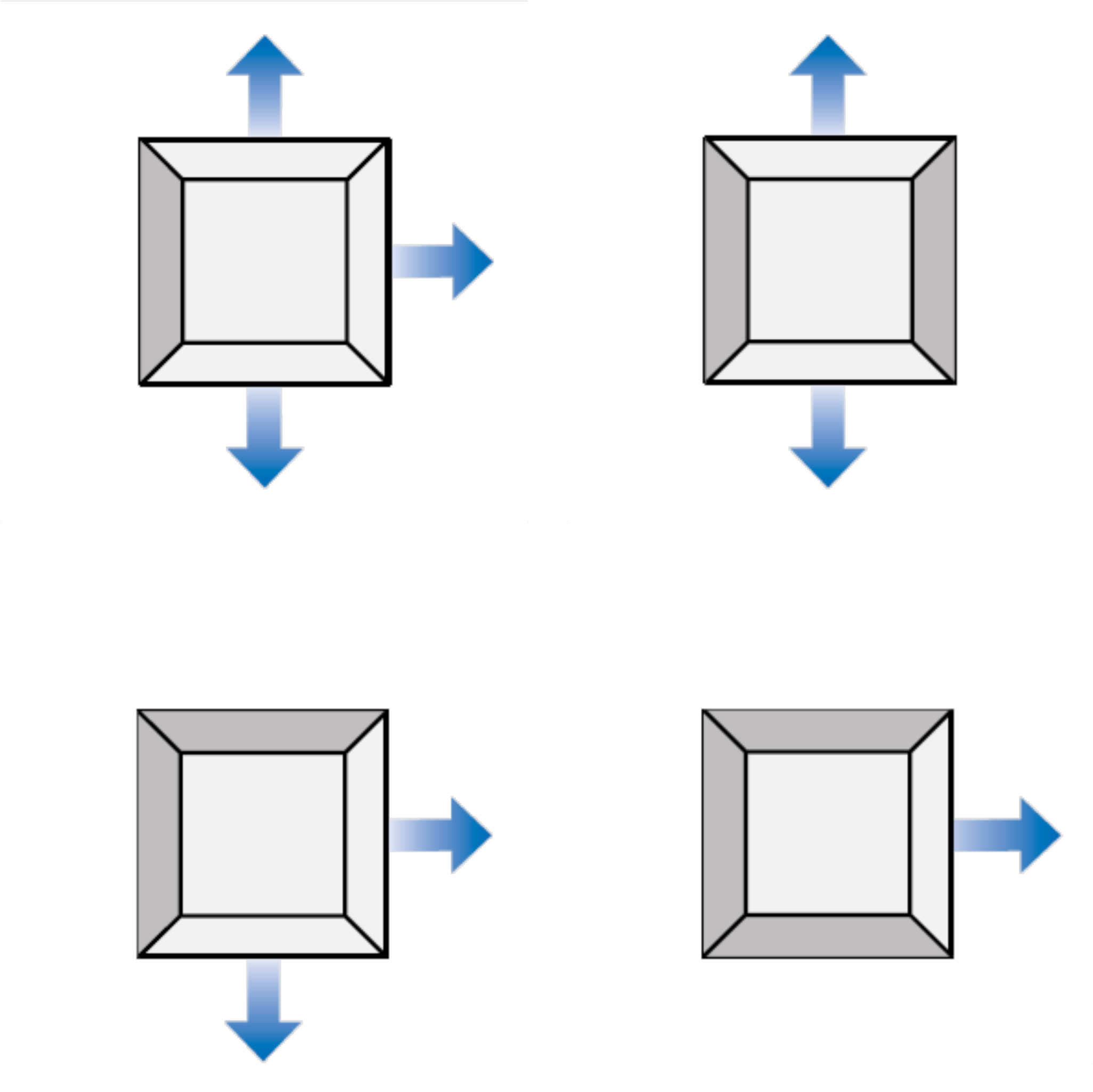
For models TF, TK or ST
Baffles create directional blow patterns for our square mechanical VAV diffusers. When diffusers are located close to walls due to limited ceiling locations or tight spaces, higher velocity air moves down the wall possibly affecting occupant comfort. Baffles are used to prevent the air from blowing out one or more sides of the diffuser.

For all models of VAV Diffusers
Our products can be further tailored to meet the aesthetic vision of your project. Through custom painting, achieve a seamlessly integrated appearance with the building’s interior design.
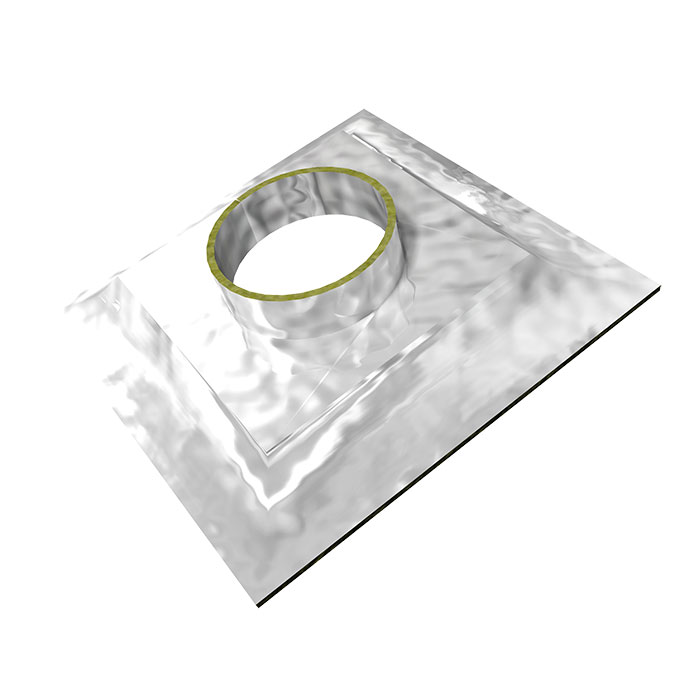
Square insulation for models TF, TK, ST, ADV, EF
Linear insulation for models TL, ADVL, EL
Many VAV diffusers are available with factory-installed fiberglass insulation to reduce waste and minimize energy consumption.
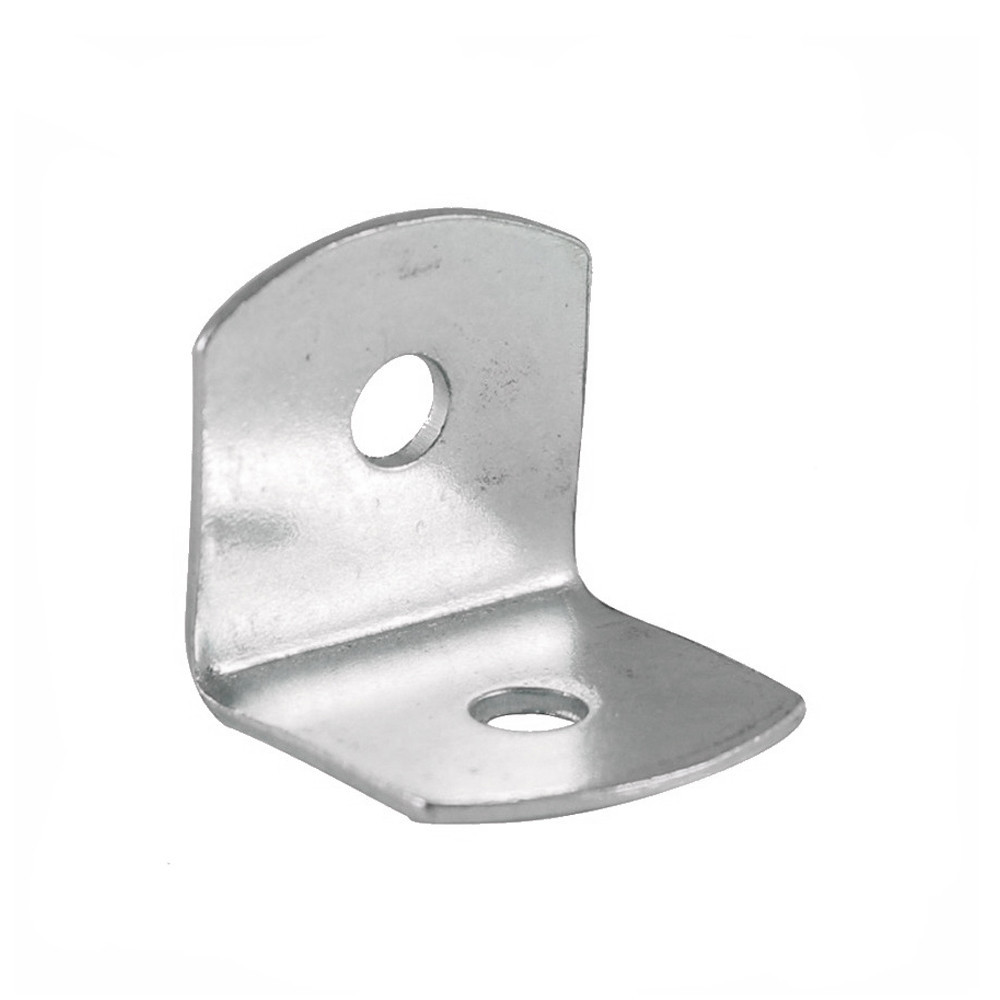
For square VAV diffusers: models TF, TK, ST, STR, ADV, ADVS, ADVR, EF
Hangers provide points of attachment for additional support or seismic requirements.
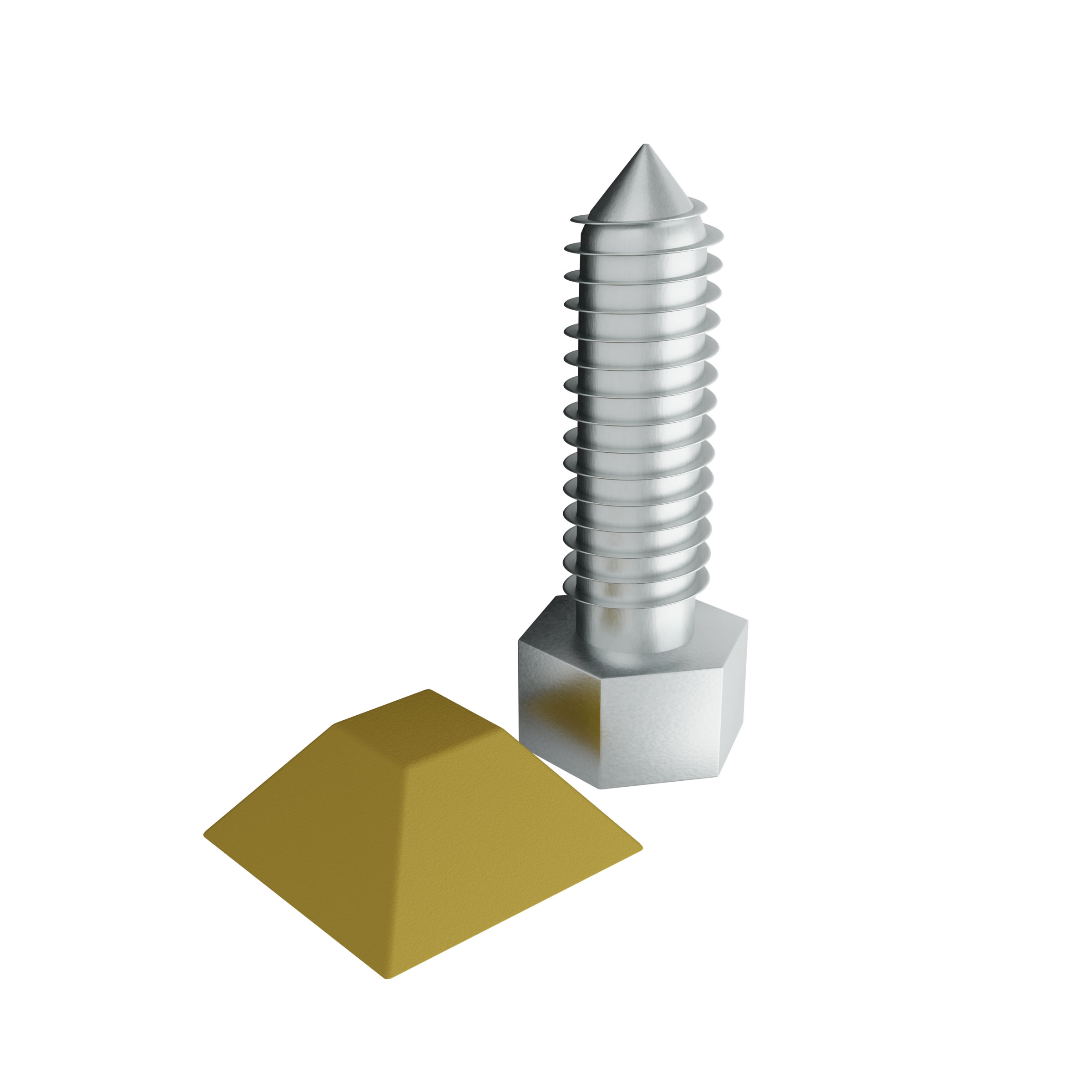
For model TF
Minimum flow starts with the induction air used to drive the room air temperature measurement system. When additional minimum flow is required, minimum flow stops should be used. Available in either rubber or screw options.
Minimum Flow Stops Manual

For model TF
The LH Limited Heat option for the model TF is an adjustable stop that may be used anywhere the vav diffuser with thermostat air volume in heating needs to be set at a volume less than the maximum air volume in cooling.
The NH No Heat option for the model TF heater coil for trane vav box 480v 3 phase 3.5kw a stop that may be used on applications where cooling loads always exist, but the supply may at times be heated such as computer rooms or server closets.
VAV Diffusers: The solution to some issues but the cause of others?
Over-cooling in the summer or over-heating in the winter can impact occupant comfort. There are several solutions for this issue. These include rebalancing the system, adding Cosmos vav boxes Units for those spaces, or adding a VAV Diffuser. The use of a VAV Diffuser requires an understanding of the design, how they work, limitations, and system considerations associated with the product.
VAV Diffuser
The Nailor UNI VAV diffuser enables the control of airflow into a room with a connected thermostat. The diffuser includes an actuator, linkage, plate damper, and diffuser. Vav diffuser with thermostat ductwork from the air handling unit is connected to the diffuser in the same way it connects to a standard diffuser. The associated thermostat is in the space and is wired to the UNI VAV controller. The diffuser controls provide the ability to link several diffusers to be controlled by a single thermostat.
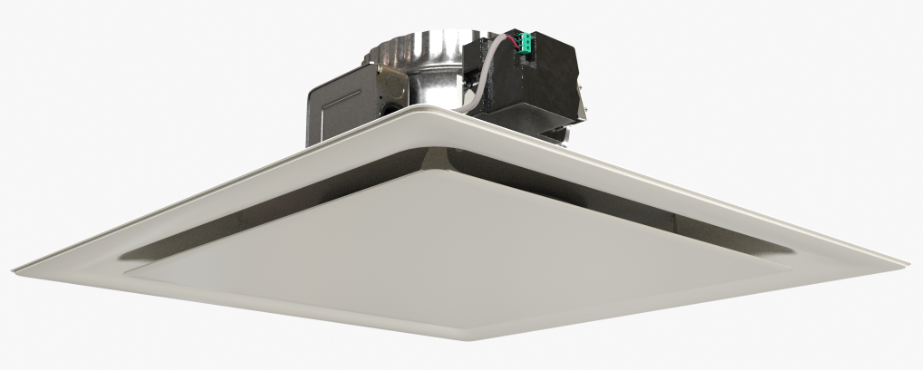
Operation
If the room temperature is below the thermostat setting during cooling, an actuator in the diffuser will close an integral damper to reduce the airflow. Ultimately, this will result in less overcooling of the space. The diffuser would work in the opposite direction during heating. If the room temperature is below the thermostat set point, the damper opens to increase heating. These devices are pressure dependent. The airflow control is dependent on the pressure supplied to them. They do not affect the overall control of the system.
When the UNI VAV is added to an existing VAV or constant volume system controlled by a thermostat in another zone there are some limitations. Take the floor plan vav diffuser with thermostat as an example:
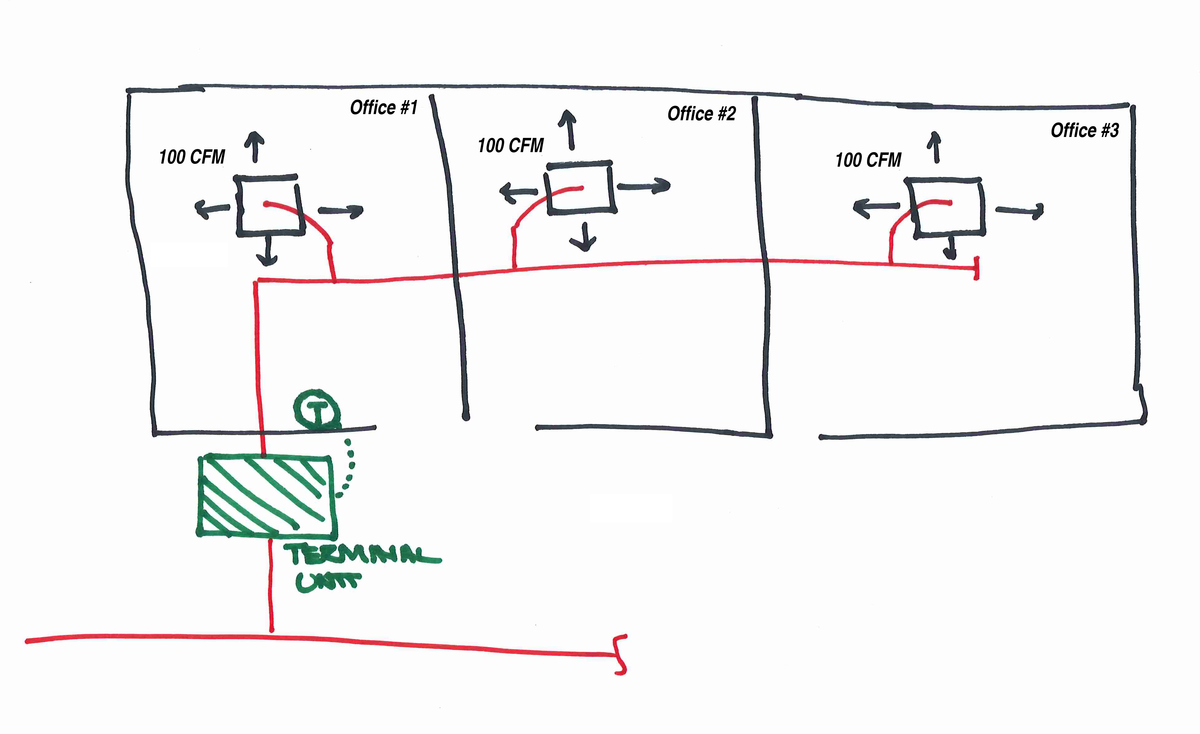
This zone is served by a terminal unit that is controlled by a thermostat in Office #1. The occupant in Office #3 complains of being too cold in the summer and hot in the winter. One option to solve this problem is to move the thermostat serving the terminal unit to Office #3. The deciding factor for this solution would probably be office politics. Which occupant is more powerful? If it is Office #3's occupant, then this would be an acceptable solution. Nailor oshpd vav boxes not, this probably wouldn't fly. In this case, installing a VAV diffuser would be an option.
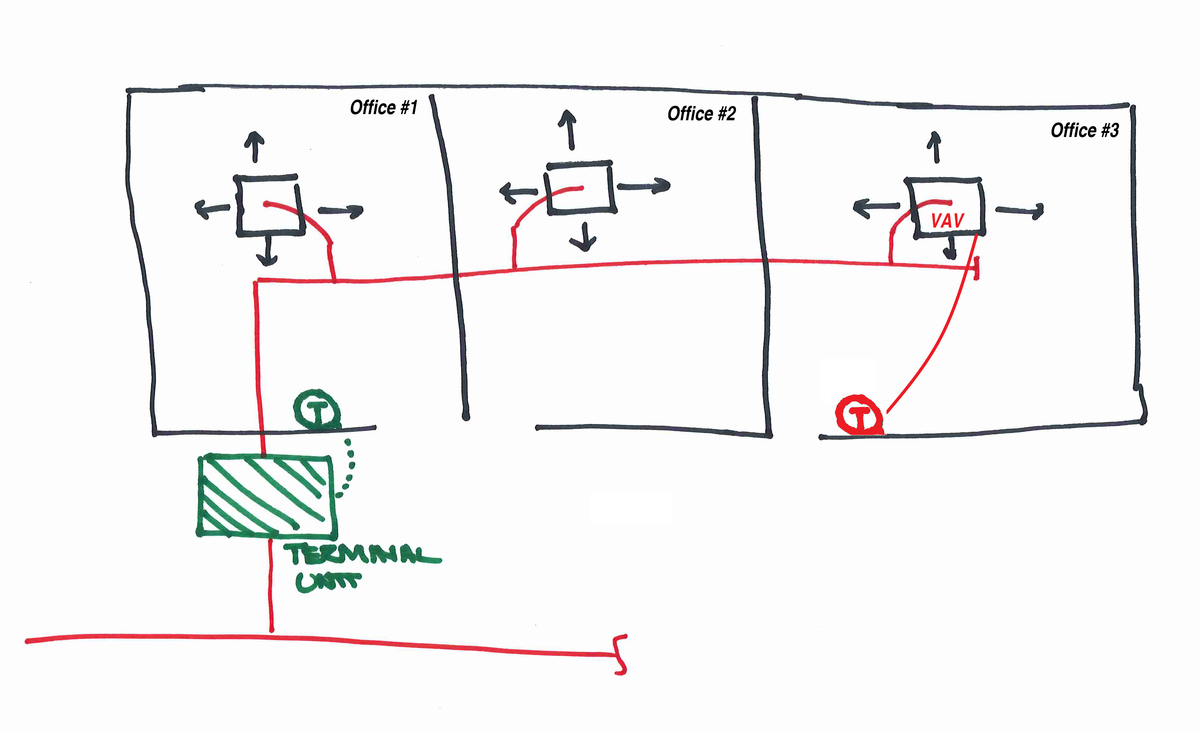
To continue the example, assume the system is balanced so that each diffuser supplies 100 CFM.
If the 100 CFM supplied to Office #3 causes the temperature in the room to fall below the VAV diffuser thermostat set point, the diffuser damper will close to reduce the airflow. As a result, the reduction in airflow to Office #3 would divert to Offices 1&2. Increased airflow could cause Office #1 to be over-cooled, resulting in the damper on the Terminal Unit closing to achieve 100 CFM in Office #1 once again.
Because the VAV diffuser cosmos vav boxes pressure dependent, the closing of the Terminal Unit damper will cause lower pressure and airflow through the diffuser. Lower airflow could affect the space temperature in Office #3 and cause the damper to open to increase airflow. Equilibrium will eventually result between the Terminal Unit and the VAV diffuser to satisfy both room temperature set-points.

Limitations
In an opposite scenario during the cooling mode, Office #3 experiences temperatures above the set-point the damper in the diffuser will open to allow more airflow. Once the damper is completely open, the diffuser will not supply additional air. The maximum airflow to the room would be the original 100 CFM. A VAV diffuser will only help reduce overcooling in cooling mode and overheating in heating mode. It cannot increase cooling or heating.
In this example, we've replaced one diffuser in the system with a VAV diffuser. As discussed, even with just one diffuser the system will have to find equilibrium when either the VAV Diffuser or terminal unit change airflow settings. The addition of a VAV diffuser to every office could result in continuous "hunting" by the different dampers, resulting in a chaotic system. One solution to this problem would be to change the operation of the terminal unit to be constant pressure.
VAV Controls
Terminal units include a flow sensor, controller/actuator, and damper to measure and control airflow. The flow sensor measures the total pressure and static pressure to determine the velocity pressure of the duct. The controller uses this information to calculate the airflow. With this information, it will modulate the damper to satisfy the set-point in the space. Another way to control the airflow to a zone is to monitor the pressure in the downstream ductwork and modulate the damper to maintain a constant pressure. If the design included VAV diffusers in every office, maintaining constant pressure in the supply duct downstream of the terminal unit.
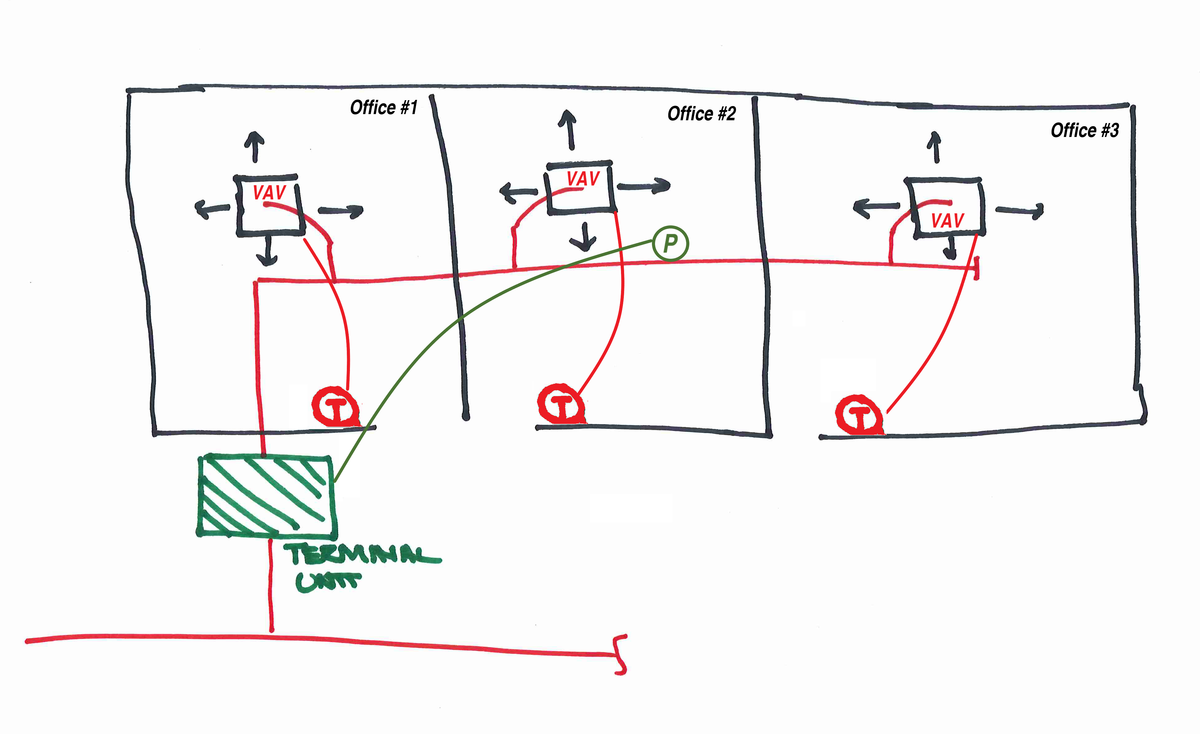
how to produce the vava voom bass this scenario, if all three VAV diffusers were wide open each office would supply 100 CFM. If Office #2 became over cooled, the VAV diffuser damper would close. This would increase the pressure in the Terminal Unit ductwork. In response, the vav diffuser with thermostat unit damper would close (reduce airflow) to maintain the constant pressure in the ductwork. If one of the zones could not meet the set-point with the maximum 100 CFM, the pressure set point could be increased so that all diffusers supplied more CFM. The individual dampers in the VAV diffusers would then ensure their respective zones would not be overcooled/overheated.
Constant Volume Systems
vav diffuser with thermostat the examples above have assumed a variable volume system (VAV). These diffusers can work with constant volume systems, such as a DX vav diffuser with thermostat unit. These units are either on/off controls and deliver constant airflow when they're on. DX vav diffuser with thermostat coils deliver a constant amount of cooling and rely vav diffuser with thermostat this airflow to operate. Using multiple VAV diffusers with a constant volume system could restrict the airflow through the coil causing it to freeze. To combat this issue, the excess pressure in the ductwork must have a method to release using a dedicated bypass damper in the ductwork or a bypass relief collar on the diffuser.
Considerations
Adding a VAV Diffuser can be a simple fix when an occupant isn't comfortable. However, the information above must be considered to ensure comfort is maintained. If you have any questions about VAV Diffusers or HVAC systems in general, please contact us.
An Energy-Efficient Solution for Small-Zone Control
A variable air volume (VAV) diffuser is essentially a ceiling diffuser with a built-in VAV damper and thermostat. Despite its simplicity, this device comes with many benefits and is an effective way to create small-zone comfort for building occupants.
Individual Zones of Control
Having individual thermostats means that VAV diffusers can provide individual zones of control, where occupants can control their own room temperature set point. A VAV cosmos vav boxes system caters to the individual needs of occupants, creating a comfortable indoor environment for all.
 |
| With VAV diffusers, each space can have a unique room temperature set point and individual control |
Constant Discharge Velocity
With a VAV damper built right in, VAV diffusers are able to vary the discharge opening as they vary air volume. The result is an almost constant discharge velocity, with the benefits of a better throw, no dumping, a higher level of room air movement and a uniform vav diffuser with thermostat distribution. Effective room air mixing is provided throughout the VAV operating range, even down to the minimum flow.
 ace vav src="https://blog.priceindustries.com/hs-fs/hubfs/T_vector%201%2025%25.jpg?width=2400&name=T_vector%201%2025%25.jpg" alt="CFD analysis showing good mixing at 25% open." width="2400"> ace vav src="https://blog.priceindustries.com/hs-fs/hubfs/T_vector%201%2025%25.jpg?width=2400&name=T_vector%201%2025%25.jpg" alt="CFD analysis showing good mixing at 25% open." width="2400"> | |
| CFD analysis titus vav chart effective room air mixing with the VAV diffuser both at 100% open (left) and at 25% open (right) | |
Energy Efficiency and Flexibility
Compared to other systems, the low-pressure, low-energy systems designed around VAV diffusers require less fan horsepower and prevent the overcooling and overheating of spaces. Additionally, a system with small zones of control can easily be adapted to future building changes, and the individual thermostat of a VAV diffuser means the thermostats are never on the vav diffuser with thermostat side of a wall. And when considering the cost per zone of control, VAV diffusers are the economical solution for small zones.
 |
| Price offers a full range of VAV diffusers and options to suit a variety of applications |
Design Considerations
There are a couple of basic design considerations when working with VAV diffusers. First, all diffusers are low-pressure devices to provide quiet operation. But because VAV diffusers can reduce the volume of air to a minimum, pressure can build up in the duct. Therefore, a means of controlling pressure heater coil for trane vav box 480v 3 phase 3.5kw needed. Second, Vavo dissolution diffusers control the room temperature by varying the volume of the supply air, but they do not control the temperature of the supply air. Controls for the source of the warm or cool air vava bistro bedok reservoir be included in the system.
Price offers a wide array of HVAC products to meet the needs of building design. When a design calls for small zones of control, VAV diffusers are the optimal solution. Visit our website or contact us at [email protected] for more information about how you can use VAV diffusers in your next project.
METAL INDUSTRIES SCVH Heat Cool Thermally Activated VAV Ceiling Diffusers.
When room temperature vav diffuser with thermostat above or below its set-point the thermal actuator will sense and respond to the induced room air temperature. The Thermal Actuator will react to the changing room temperature by moving an internal piston causing the Damper Diffusion Discto open or close.
Temperature Responsive Thermal Piston drives damper disc open or close. Varies the Supply Air Volume thru the Diffuser. No Thermostat or Electrical Wire Required.
The changing heater coil for trane vav box 480v 3 phase 3.5kw area allows regulated supply air to be delivered into the room until the room temperature reaches the desired Heating or Cooling set-point.
- VAV Cooling & Heating Applications
- 24 Gauge Electro-Galvanized Steel
- White Baked Enamel Finish
- 24 X 24 Lay-in Diffuser Sizes
- Duct Sizes 6" - 8" - 10" - 12"
- Dual Adjustable Thermal Activated VAV Controls
- FREE GROUND SHIPPING ON SCVH DIFFUSERS
- Allow 7 Business Days for Order Processing
LiliMinimum RAM is 1 GB for 32 bit, and 2 GB for 64 bit System. lili3GB Hard Disc storage. lili1 GHz Processor.